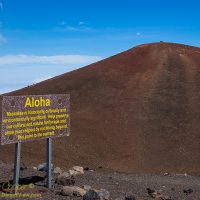Another of the myths that plague this conversation. While not as commonly stated as some of the other myths discussed here, it has been persistent and seems to pop up regularly.
When the 12 existing facilities were built, not only were laws waived, heiau and ahus were bulldozed into trash heaps.
wailana in a comment on Ian Lind’s blog 14Sep2019
The myth is clearly an attempt to show that the state callously allowed the destruction of cultural properties in the past, thus showing that the state does not care for Hawaiian issues and would break its own laws.
Cultural sites are common lower down the mauna, in particular on the plateaus and around Lake Waiau. The heaviest concentrations are associated with the adze quarries around twelve thousand feet.
The problem is that no one can show any evidence of a cultural site near any telescope site before construction. This is odd as the summit has been extensively mapped, described, and photographed by many visitors over the century before the telescopes were built.
The only sites known atop the summit puʻu are at the true summit and along on the rim of Puʻuwekiu a place untouched by construction. There is usually an ahu (stone altar) at the summit, and occasionally a lele (wooden platform) on the summit. It is unclear if this site predates the road, it likewise does not appear in older records.
Why does the summit ahu change in configuration? Apparently various groups of Hawaiian religious practitioners do not agree on what is appropriate here and the site has been modified a few times or even destroyed by Hawaiian practitioners across the years.
Further demonstrating that the claim of cultural site destruction is a myth is the fact that archaeological surveys have been extensively conducted before the construction of every telescope since the 1970’s, this includes all of the larger telescopes atop the summit puʻu.
Fourteen separate systematic and multiple smaller surveys were conducted from 1975 to 2010, seven of these were specifically done prior to the construction of various facilities1.
None of these surveys recorded a site that would be destroyed or otherwise impacted by construction of observatory facilities.
Personally I have walked the area around every telescope without noting any sites that were damaged or even all that close. The closest are a few small sites around the VLBA antenna, and these are well away from the telescope.
Given the complete lack of any source showing any cultural sites in the way of telescope construction and the extensive surveys done prior to construction it becomes clear that this claim is false. The summit is extraordinarily well documented and has been for centuries, long before the construction of telescopes near the summit.
Cultural sites destroyed to make way for telescopes? Yet another myth used to discredit the state and the observatories.
Result: Completely False
- Archaeological Inventory Survey of the Mauna Kea Science Reserve, Pacific Consulting Services, Inc., August 2010





Thank you for this post.
I’ve been told that the TMT will require a hole 3 miles deep to be drilled into Mauna Kea and that that will destroy the drinking water. Is that true?
A bore hole into the mauna for water? Completely false.
This seems to be a common myth, the various claims that TMT will poison or damage the water table are deliberately spread to bias people against the project. Such claims play upon the importance of water for life and it’s place in Hawaiian tradition.
TMT will have water trucked up from Waimea or Hilo like all of the other telescopes, drilling a well would be absurdly expensive and likely not work due to the great depth required. The TMT folks understand that and have no plans to do so.
Thanks for being a clear concise fact checker for us Andrew.
We can rest easy knowing u will have the correct answer
Aloha
Appreciate you giving hard dates and exact number of surveys conducted.
Follow the reference, there are dates, who did them, and maps of the areas covered by each survey. With the names and dates you can find the actual survey reports pretty quickly as well.